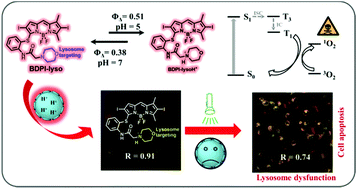A novel BODIPY-based photosensitizer with pH-active singlet oxygen generation for photodynamic therapy in lysosomes†
Abstract
A novel photosensitizer BDPI-lyso has been developed for photodynamic therapy (PDT). The photosensitizer BDPI-lyso showed a high singlet oxygen quantum yield (ΦΔ = 0.95) and low fluorescence quantum yield (ΦF = 0.05) in EtOH. Different singlet oxygen quantum yields were found in acidic solution (pH = 5, ΦΔ = 0.51) and in neutral solution (pH = 7, ΦΔ = 0.38). DFT and TD-DFT calculations of BDPI-lyso and its protonated product BDPI-lysoH+ indicated that the S1/T3 transition was responsible for the intersystem crossing (ISC) enhancement which would promote the production of singlet oxygen. The negligible dark cytotoxicity toward the hepatoma cell line Bel-7402 was confirmed by MTT assay, AO/EB dual staining, and cell images. Upon exposure to a low dose of light illumination, the disruption of the cell plasma membrane and the calculated half-maximal inhibitory concentration (IC50) of 0.4 μM showed a high phototoxicity of the photosensitizer BDPI-lyso. The light-induced intracellular ROS generation was verified as the PDT mechanism of BDPI-lyso. Colocalization experiments of LysoTracker Green and BDPI-lyso in the dark indicated the good lysosome-targeting ability of BDPI-lyso. The images of cells costained with LysoTracker Green and BDPI-lyso, and the appearance of intracellular and extracellular blebs with green fluorescence after light illumination revealed the light-induced dysfunction of lysosomes and cell apoptosis.



 Please wait while we load your content...
Please wait while we load your content...